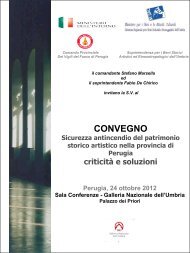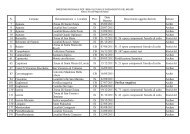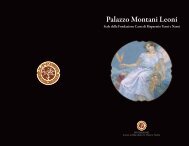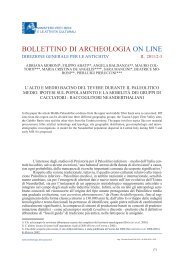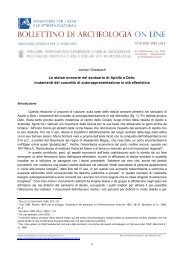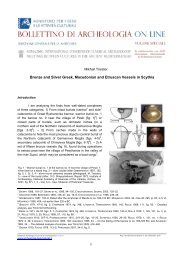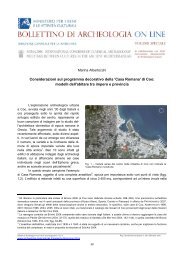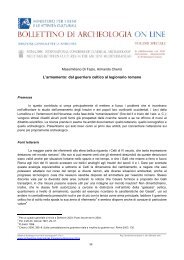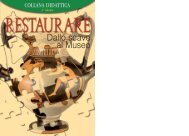Late Hellenistic Settlements in Hawrān (Southern Syria). Survival of ...
Late Hellenistic Settlements in Hawrān (Southern Syria). Survival of ...
Late Hellenistic Settlements in Hawrān (Southern Syria). Survival of ...
You also want an ePaper? Increase the reach of your titles
YUMPU automatically turns print PDFs into web optimized ePapers that Google loves.
XVII International Congress <strong>of</strong> Classical Archaeology, Roma 22-26 Sept. 2008<br />
Session: Formation d’une culture urba<strong>in</strong>e aux marges du désert syro-arabique: espaces urba<strong>in</strong>s et périurba<strong>in</strong>s<br />
Middle Bronze Age. The wide tell which lies <strong>in</strong> the western part <strong>of</strong> the city dates back to this period (fig. 2) 7 .<br />
The city reappears <strong>in</strong> the historical record <strong>in</strong> the first half <strong>of</strong> the 2 nd c. BC, as the first book <strong>of</strong> the Maccabees<br />
reports an expedition <strong>of</strong> Juda and Jonathan Maccabee aga<strong>in</strong>st Bosra <strong>in</strong> the years 164-163 8 . The city was<br />
probably annexed by the Nabataean k<strong>in</strong>gdom at the end <strong>of</strong> the 2 nd c. BC, although there is no epigraphic<br />
evidence for the presence <strong>of</strong> Nabataeans until the 1 st c. AD 9 . Most <strong>of</strong> the archaeological rema<strong>in</strong>s which are<br />
visible today date back to the Roman and Byzant<strong>in</strong>e period. However, the excavations carried out by the<br />
French Expedition s<strong>in</strong>ce 1981 provide new clues as to the probable location <strong>of</strong> the <strong>Hellenistic</strong> settlement.<br />
New sound<strong>in</strong>gs <strong>in</strong> the western part <strong>of</strong> the city suggest that the ancient tell was occupied at least until the Iron<br />
Age II, and that its western rampart was rebuilt <strong>in</strong> the late 1 st c. BC 10 . Conversely, deep sound<strong>in</strong>gs conducted<br />
<strong>in</strong> the monumental area, i.e. the central and eastern parts <strong>of</strong> Bosra, have shown very few traces <strong>of</strong><br />
occupation prior to the reign <strong>of</strong> the Nabataean k<strong>in</strong>g Rabbel II, <strong>in</strong> the second half <strong>of</strong> the 1 st c. AD 11. These data<br />
suggest that the city rema<strong>in</strong>ed conf<strong>in</strong>ed to the old fortified tell until a relatively late date. Unfortunately, save<br />
for its location, the features <strong>of</strong> the <strong>Hellenistic</strong> agglomeration rema<strong>in</strong> so far completely unknown. It is also<br />
unclear whether the occupation <strong>of</strong> the tell was cont<strong>in</strong>uous between Iron Age II and the <strong>Hellenistic</strong> period.<br />
In the South-western part <strong>of</strong> Hawrân, on the Jedur plateau, the city <strong>of</strong> Dion or Diospolis - which until<br />
recently was only known through literary references - should most certa<strong>in</strong>ly be identified with Tell al-Ash‘ari,<br />
on the banks <strong>of</strong> a major affluent <strong>of</strong> the Yarmuk river 12 . The site is be<strong>in</strong>g excavated by a <strong>Syria</strong>n expedition led<br />
by Q. al-Mohammed. Although the story <strong>of</strong> its foundation by Alexander is probably legendary, it was an<br />
important urban centre by the beg<strong>in</strong>n<strong>in</strong>g <strong>of</strong> the 1 st c. BC, and it belonged to the Decapolis 13 . For the time<br />
be<strong>in</strong>g, no <strong>in</strong>formation is available concern<strong>in</strong>g the urban development <strong>of</strong> the city <strong>in</strong> the <strong>Hellenistic</strong> period, as<br />
the excavated monuments seem to date back to the 2 nd c. AD at the earliest. The date <strong>of</strong> the foundation <strong>of</strong><br />
the <strong>Hellenistic</strong> city, as well as the cont<strong>in</strong>uity <strong>of</strong> occupation between the Iron Age and the <strong>Hellenistic</strong> period,<br />
are still pend<strong>in</strong>g issues. However, it is <strong>in</strong>terest<strong>in</strong>g to note that the <strong>Hellenistic</strong> and Roman city has developed<br />
on a 10 ha fortified tell, whose occupation dates back to the Middle Bronze Age.<br />
The Jebel al–‘Arab<br />
In the Jebel al-‘Arab, the only polis attested <strong>in</strong> the <strong>Hellenistic</strong> period is Qanawât/Canatha, on the<br />
western slopes <strong>of</strong> the mounta<strong>in</strong>. A member <strong>of</strong> the Decapolis, Canatha was founded (or refounded) <strong>in</strong> the<br />
years follow<strong>in</strong>g Pompey’s conquest s<strong>in</strong>ce it bears the epithet Gab<strong>in</strong>ia on some <strong>of</strong> its co<strong>in</strong>s 14 . However, no<br />
def<strong>in</strong>ite traces <strong>of</strong> the <strong>Hellenistic</strong> phases <strong>of</strong> the city have been uncovered so far. The dat<strong>in</strong>g <strong>of</strong> a number <strong>of</strong><br />
monuments (temples, nymphaeum, odeon, tombs) <strong>in</strong> the second half <strong>of</strong> the 1 st c. BC rests on purely<br />
typological arguments and f<strong>in</strong>ds no consensus among scholars 15 . It must therefore be taken with great<br />
caution.<br />
The <strong>Hellenistic</strong> phases are better documented <strong>in</strong> the neighbour<strong>in</strong>g city <strong>of</strong> Suweida/Soada, which is<br />
located some 7 km south <strong>of</strong> Qanawât, at the <strong>in</strong>terface between the mounta<strong>in</strong>s and the pla<strong>in</strong> (fig. 3). Until<br />
recently, Soada was considered a prosperous village which progressively grew <strong>in</strong>to a city <strong>in</strong> the Roman<br />
period. However, a campaign <strong>of</strong> excavations and surveys conducted between 1996 and 1999 by M. Kalos<br />
and F. Renel has significantly changed this perception 16 . The campaign has led to the identification <strong>of</strong> a 3 ha<br />
walled tell <strong>in</strong> the heart <strong>of</strong> the old city. This agglomeration has an irregular oval form and is enclosed by two<br />
7<br />
DENTZER ET AL. 2002; SEEDEN 1986.<br />
8<br />
I Macc, 5, 28.<br />
9<br />
SARTRE 1985; 2001, 411–424; DENTZER-FEYDY ET AL. 2007.<br />
10<br />
BRAEMER 2002.<br />
11<br />
The only possibly earlier rema<strong>in</strong>s are those <strong>of</strong> a domestic unit under the western part <strong>of</strong> the southern baths. They are tentatively dated<br />
between the late 1 st c. BC and the 1 st c. AD, cf. DENTZER ET AL. 2002, 94.<br />
12 SARTRE 1992; KROPP, MOHAMMED 2006; MOHAMMED Forthcom<strong>in</strong>g.<br />
13 See SARTRE 1992 for the historical record on Dion.<br />
14 For a comprehensive study <strong>of</strong> the available historical record on Qanawât, see SARTRE 1992.<br />
15 See for <strong>in</strong>stance FREYBERGER 2004 vs. AUGIER, SARTRE 2001.<br />
16 KALOS 1999; DENTZER ET AL. 2010.<br />
Bollett<strong>in</strong>o di Archeologia on l<strong>in</strong>e I 2010/ Volume speciale G / G5 / 2 Reg. Tribunale Roma 05.08.2010 n. 330 ISSN 2039 - 0076<br />
www.archeologia.beniculturali.it<br />
3



